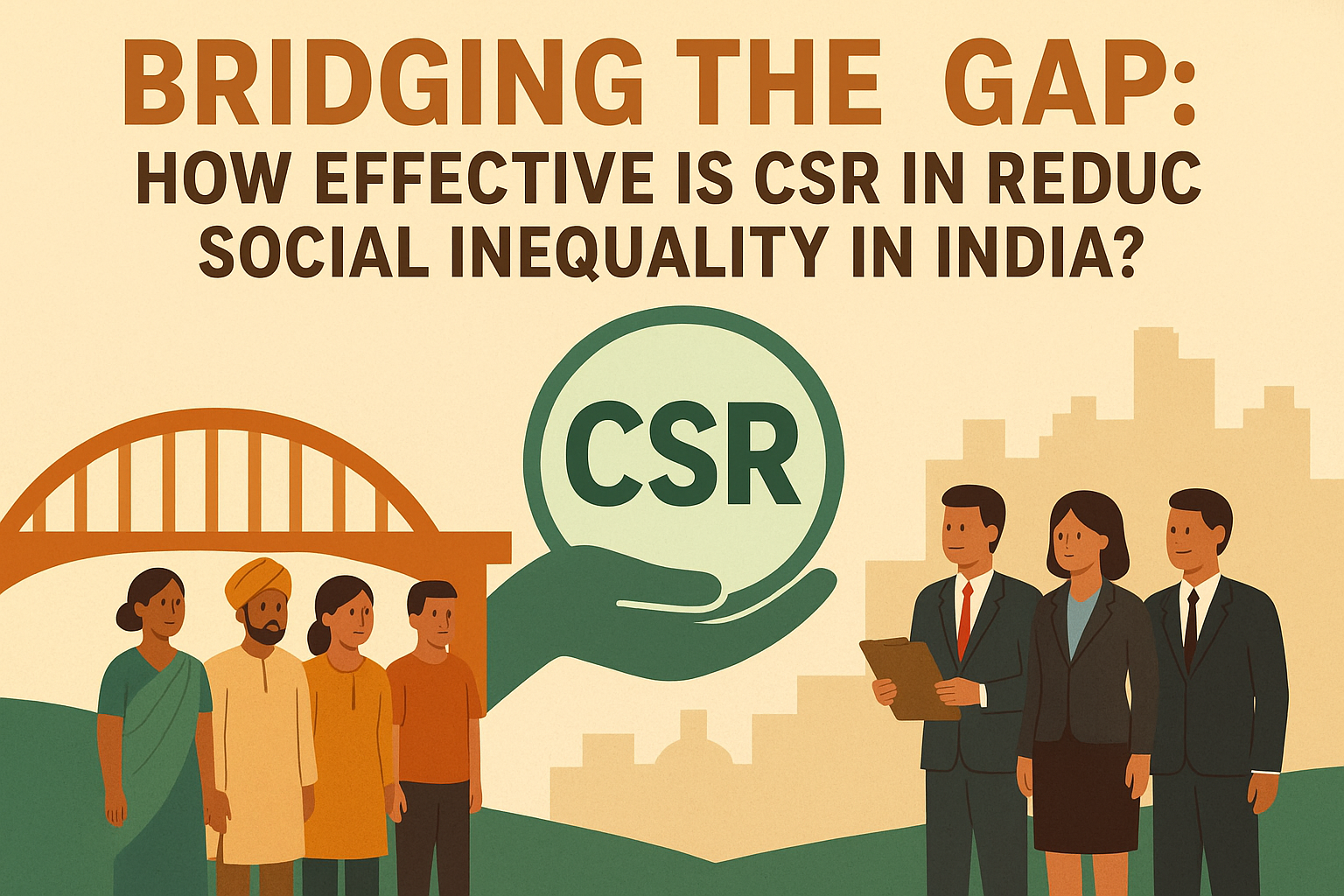View News
Bridging the Gap: How Effective is CSR in Reducing Social Inequality in India?

Bridging the Gap: How Effective is CSR in Reducing Social Inequality in India?
Introduction
In India, corporate social responsibility (CSR) has emerged as a vital tool for fostering inclusive growth and development. Modern businesses are expected not only to pursue profits but also to contribute meaningfully toward addressing societal challenges by embedding social and environmental concerns into their operations. Among these challenges, social inequality remains one of the most pressing. Despite impressive economic growth, India continues to struggle with stark disparities in income, education, healthcare, and access to opportunities. Against this backdrop, CSR has been positioned as a potential instrument to bridge these divides. The key question, however, is: How effective has CSR been in addressing social inequality in India?
India’s Legal Framework for CSR
India became the first country in the world to make CSR mandatory through the Companies Act, 2013. Under Section 135, companies meeting specific financial thresholds—net worth of Rs 500 crore or more, turnover of Rs 1,000 crore or more, or net profit of Rs 5 crore or more—must allocate at least 2% of their average net profits toward CSR activities. The Act also identifies priority areas, including poverty alleviation, education, healthcare, gender equality, rural development, and environmental sustainability.
This legal mandate has created a steady flow of funds into social projects. Since 2014, Indian corporates have collectively invested thousands of crores annually in CSR programs. Notably, significant resources have been directed toward education, healthcare, and rural development—sectors that directly influence inequality reduction.
CSR’s Role in Reducing Inequality
1. Education and Skill Development
Many companies have prioritized access to quality education for underprivileged children through initiatives such as scholarships, digital classrooms, skill training centers, and midday meal programs. By equipping marginalized groups with knowledge and skills, CSR reduces educational gaps and enhances economic participation in the long run.
2. Access to Healthcare
CSR initiatives have helped strengthen healthcare infrastructure, particularly in rural and underserved regions. Programs ranging from maternal health services and immunization drives to mobile health clinics have significantly expanded access to essential medical care for vulnerable populations.
3. Women’s Empowerment
Several CSR programs actively support women’s empowerment by promoting entrepreneurship, self-help groups, microfinance access, and vocational training. These initiatives not only promote gender equality but also enhance women’s economic independence, thereby narrowing gender-based disparities.
4. Rural Development
Corporates have invested in projects aimed at improving basic rural infrastructure—such as clean drinking water, sanitation facilities, renewable energy, and rural roads. These projects reduce the rural–urban divide and foster inclusive growth.
5. Employment Generation
Skill development programs supported under CSR have enabled marginalized youth to secure employment across manufacturing, IT, and service sectors. By providing sustainable livelihood opportunities, CSR has played a role in lifting communities out of poverty.
Challenges and Limitations
Despite these achievements, the role of CSR in addressing inequality faces critical limitations:
-
Urban-Rural Imbalance: A large share of CSR funds is concentrated around industrial hubs and urban centers, leaving many remote and underserved areas behind.
-
Short-Term Focus: Many CSR activities remain one-time charitable contributions—such as health camps or distribution of supplies—rather than sustainable, systemic solutions.
-
Preference for Visibility: Companies often choose high-profile projects like building schools or hospitals to enhance brand visibility, which may not always align with the most urgent community needs, such as caste discrimination or land rights.
-
Over-Reliance on Corporates: Dependence on CSR shifts responsibility from the state to private businesses. Moreover, CSR funding—being linked to company profits—is neither stable nor sufficient to address deep-rooted inequalities.
The Way Forward
For CSR to truly reduce inequality, the following measures are essential:
-
Prioritizing Marginalized Groups: CSR should target vulnerable communities such as Scheduled Castes, Scheduled Tribes, women, and persons with disabilities, with a focus on empowerment rather than charity.
-
Collaboration with NGOs and Government: Partnerships can ensure that CSR funds are directed toward genuine community needs, reduce duplication, and promote sustainable models.
-
Long-Term Focus: Corporates should shift toward capacity-building initiatives in education, healthcare, and livelihoods to create lasting impact.
-
Robust Monitoring Mechanisms: Transparent reporting, third-party audits, and community involvement in project planning are critical for accountability.
-
Geographic Diversification: CSR funds must reach remote and rural regions where inequality is most acute, rather than being concentrated in industrial clusters.
Conclusion
CSR in India has undoubtedly made positive contributions by complementing government efforts to promote inclusive development. Corporate initiatives in education, healthcare, rural development, and women’s empowerment have generated meaningful social impact. However, entrenched inequalities rooted in caste hierarchies, land distribution, and unequal access to resources cannot be dismantled through CSR alone.
To be effective, CSR must evolve from a compliance-driven activity into a transformative instrument focused on long-term social justice and inclusivity. With stronger alignment between corporate initiatives, government schemes, and community participation, CSR can serve as a powerful driver for reducing inequality and building a more equitable India.
"Unlock the Potential of Legal Expertise with LegalMantra.net - Your Trusted Legal Consultancy Partner”
Disclaimer: Every effort has been made to avoid errors or omissions in this material in spite of this, errors may creep in. Any mistake, error or discrepancy noted may be brought to our notice which shall be taken care of in the next edition In no event the author shall be liable for any direct indirect, special or incidental damage resulting from or arising out of or in connection with the use of this information Many sources have been considered including Newspapers, Journals, Bare Acts, Case Materials , Charted Secretary, Research Papers etc
Prerna Yadav
LegalMantra.net Team

